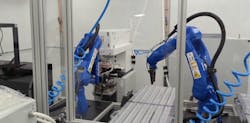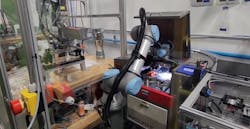Industry Increases Use of Robots-as-a-Service
The “as-a-service” model of technology delivery is most familiar through software-as-a-service (SaaS). Most companies already use Microsoft’s 365 to access Word, Excel, Outlook and Powerpoint via SaaS and the industrial software world is quickly following suit. In the past few years, Aveva, Siemens, Rockwell Automation and PTC, among others, have either released key software packages via SaaS or announced plans to transition availability of their software primarily via SaaS.
But the “as-a-service” model doesn’t just apply to software, it’s being applied to hardware as well—from packaging machinery to robotic systems. What we’re seeing now with robotics-as-a-service (RaaS) is similar to what we saw just a few years ago with SaaS, i.e., a way of accessing the technology that’s helping speed up the adoption of robots across industries at companies of all sizes.
To get a better feel for where the RaaS market stands today, we connected with Kim Losey, chief marketing officer at Rapid Robotics (a RaaS supplier) at Automate 2023 to learn more about the kinds of applications RaaS is being used for and why manufacturers are increasingly interested in the RaaS model.
Losey said the first step Rapid Robotics takes in working with a customer is to perform an assessment to understand what the company’s goals for automation success should look like. With the findings of the assessment in hand, Losey says Rapid Robotics can typically deliver and setup an automated system within weeks.
A key factor in Rapid Robotics speed of deployment is its pre-deployment of the system in its own facility before delivery to ensure the system works properly as designed. With this pre-deployment work done, Losey said Rapid Robotics can usually have the system set up and running within four to six hours after delivery.
Predictable costs
A key feature of Rapid Robotics’ RaaS offering is that all of the robot systems it supplies are cloud connected, which enables the company to provide service and support “as an extension of your own manufacturing and automation team,” said Losey. “Typically, 98% of support calls can be resolved remotely within less than an hour,” she noted, adding that if Rapid Robotics does need to come out to your facility, “we’ll have all the data to be able to diagnose the robot before we even leave our building. We'll show up on your site by the next shift and be able to make immediate changes.”
“Rapid Robotics guarantees that we will service and support your robots at no additional cost,” said Losey. “If we're traveling out to your site, there's no travel fee if something needs to be replaced and no replacement fee [for robots or parts]. It's all on us to keep it running with a subscription that provides a predictable annual operating cost that can be paid once a year, once a quarter, or once a month.”
Automotive and medical supply applications
Losey highlighted two applications in our meeting at Automate—one with an automotive supplier and another with a medical supplies manufacturer. The applications showcase Rapid Robotics partnerships with Universal Robots and Yaskawa to supply collaborative and industrial robotic systems, respectively, as needed.
In the automotive supplier’s application, a combination cartesian robot and Universal Robot cobot are used in a laser engraving application on an automotive center console component. “This is a multi-operation robotic system that saved the customer hundreds of thousands of dollars versus a traditional automation solution,” said Losey. Here, the cobot picks up the piece from the cartesian robot and places it into the laser etching machine. As the piece exits the etching machine into an air blow-off unit, the cobot picks up the piece again and transfers it to a conveyor for the next steps in assembly. Losey pointed out the custom end-of-arm tool on the cobot that not only handles the transfer of the component but also remove extraneous pieces of the component as part of the laser etching stage of production.
For the medical supplies manufacturer, three Yaskawa industrial robots are used to plasma treat and inspect syringes. “The center robot picks up the syringes and puts them into a plasma treatment before handing them off into side-by-side nests where the secondary robots pick them up and pad print them before moving them to the inspection station,” said Losey. She added that the medical supplier has been able to significantly increase throughput and win new business since having this system installed.
In the video below, Rapid Robotics' Kim Losey explains Rapid Robotics approach to Raas and highlights the two applications described above.



